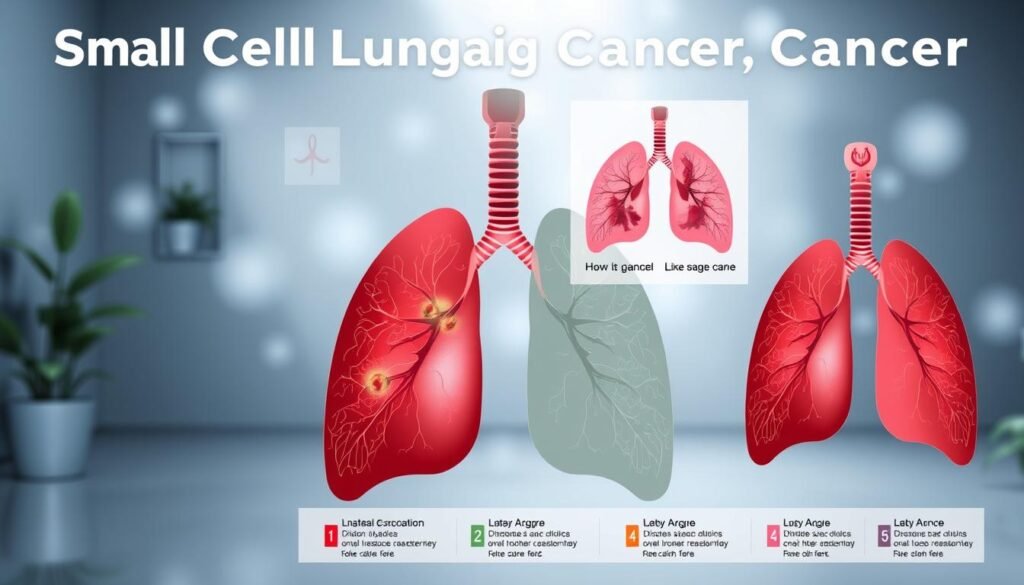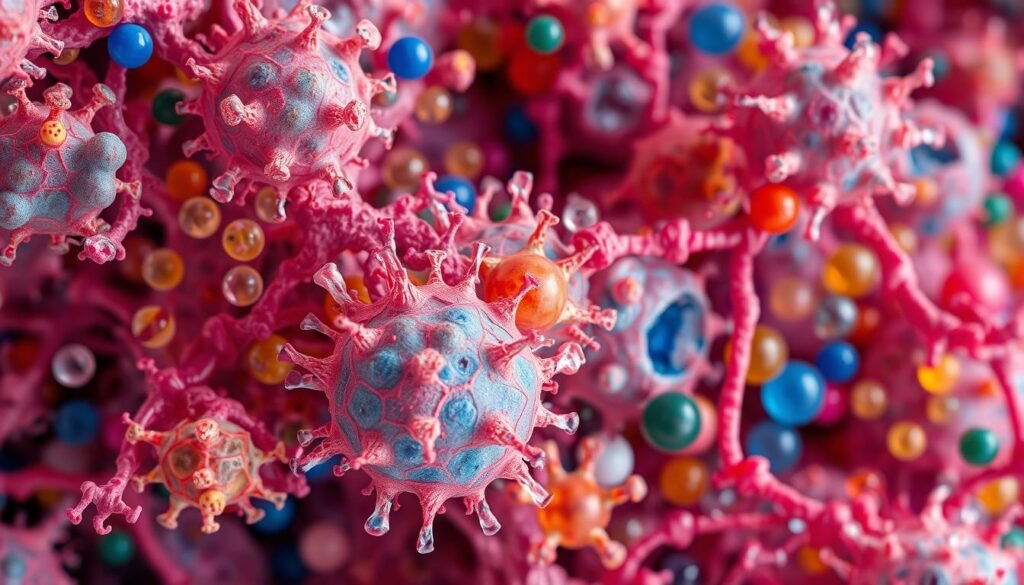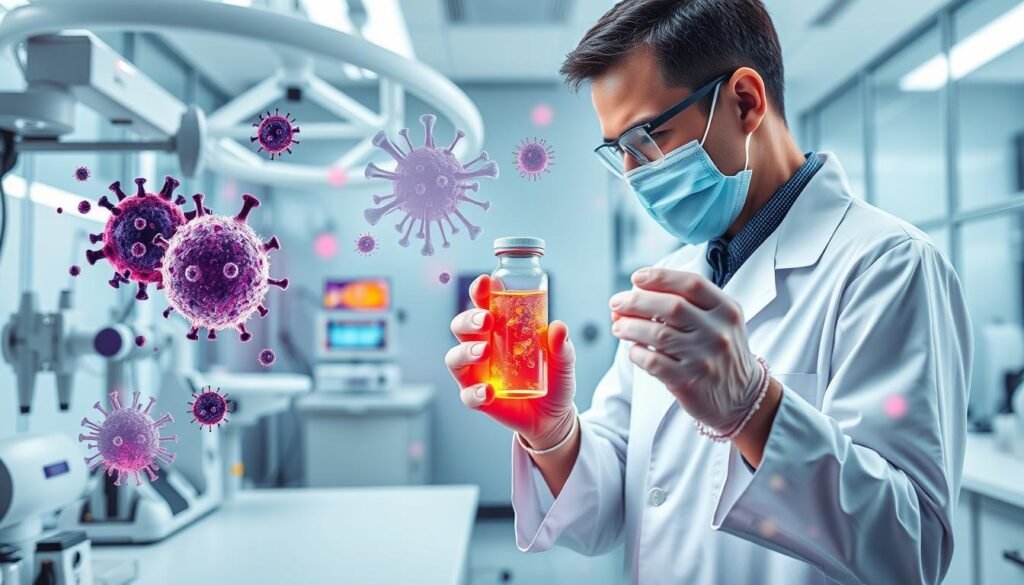Did you know that small-cell lung cancer (SCLC) makes up about 15% of all lung cancer cases? This type of cancer is mostly found in people who have smoked. It’s vital to learn about SCLC because it grows quickly and many do not survive it. Knowing about this can help those at risk make important health choices.
If someone has small cell carcinoma lung cancer, knowing the causes, treatments, and signs is key. We want to share important details about SCLC. This can help someone understand how serious it is and what it means for their health.
Key Takeaways
- Small cell carcinoma represents about 15% of lung cancer cases, primarily linked to smoking.
- A low 5-year survival rate shows SCLC is more aggressive than other lung cancers.
- Early screening can help spot it sooner, possibly leading to better results.
- SCLC usually has a much lower survival rate than non-small cell lung cancer.
- Knowing symptoms and treatment options is very important for patients and those who care for them.
What is Small Cell Carcinoma Lung Cancer?
Small cell carcinoma lung cancer, also called small cell lung cancer (SCLC), is seen in about 10% to 15% of lung cancer cases. It’s known for spreading quickly and often reaches other organs early on. SCLC is split into two main types: small cell carcinoma and combined small cell carcinoma.
Many refer to the first type as oat cell cancer because of how the cells look under a microscope. Smoking is the main cause of this cancer type. It’s vital for everyone, especially smokers, to know their risk.
By the time it’s found, it often has spread beyond the lungs. Treatment usually involves both chemotherapy and radiation because the cancer grows so fast.
Small cell carcinoma, unlike its counterpart non-small cell lung cancer (NSCLC), makes up a smaller portion of lung cancer cases and progresses quickly. It responds well to treatment initially but the chance of it coming back is high. Catching it early and managing it well is key to helping patients. For more on managing SCLC, click here.
Types of Lung Cancer
Lung cancer falls into two main types: small cell lung cancer (SCLC) and non-small cell lung cancer (NSCLC). Knowing the differences between these types is key for proper treatment.
Small Cell Lung Cancer (SCLC) is known for being very aggressive. It usually starts in cells called neuroendocrine cells. It’s closely linked to smoking. SCLC spreads quickly, making it important to catch early. This rapid spread means patients need fast treatment.
Non-Small Cell Lung Cancer (NSCLC) makes up about 85% of cases. It includes types like adenocarcinoma, squamous cell carcinoma, and large cell carcinoma. NSCLC has more treatment options, including surgery. If caught before spreading, surgery can be effective. Treatments like radiofrequency ablation (RFA) can destroy tumors in the outer lungs with high-energy radio waves.
The table below shows the main differences between these lung cancer types:
| Characteristic | Small Cell Lung Cancer (SCLC) | Non-Small Cell Lung Cancer (NSCLC) |
|---|---|---|
| Percentage of Cases | Approximately 15% | Approximately 85% |
| Growth Rate | Rapid | Slower |
| Association with Smoking | Highly linked | Moderately linked |
| Treatment Options | Chemotherapy, Radiation | Surgery, Chemotherapy, Radiation, Targeted Therapy |
Knowing about these lung cancer types helps doctors find the right treatment. This can lead to better results for patients.
Causes and Risk Factors for Small Cell Lung Cancer
Learning about small cell lung cancer and its risk factors is key for prevention. Smoking tobacco is the main cause, responsible for about 80% of lung cancer deaths. This number might be even higher for small cell lung cancer. It’s important to also look at other risks.
Secondhand smoke is a major cause of lung cancer in the US. Exposure to radon, a natural gas, is the second leading cause. The US Environmental Protection Agency has confirmed this. Jobs that involve working with asbestos also increase the risk. Being around diesel exhaust or certain chemicals can make you more likely to get lung cancer too.
Having family members with lung cancer can raise your risk slightly. Getting older and being male make it more likely as well. Also, like tobacco, marijuana smoke can be harmful. It contains substances that might increase lung cancer risk.
- Smoking tobacco
- Secondhand smoke
- Radon exposure
- Asbestos occupational exposure
- Air pollution
- Family history of lung cancer
- Age and gender
Knowing these risk factors for small cell lung cancer helps people make healthier choices. By understanding these risks, we can work on lowering them and improving our health awareness.
Small Cell Lung Cancer Symptoms
Spotting small cell lung cancer symptoms early is key to starting treatment soon. People might see various signs that impact their daily lives and health.
- Coughing that sticks around
- Shortness of breath, even with easy tasks
- Chest pain gets worse when you breathe deeply or cough
- Hoarseness in your voice
- Unplanned weight loss
- Wheezing or trouble breathing
These small cell lung cancer symptoms can be confused with other breathing issues. So, if you’re at high risk, it’s important to get a check-up. High risk factors include lots of smoking, being around harmful toxins, or having lung cancer in the family.
Symptoms usually start slowly and might be ignored for months. But spotting these signs early is a big chance. It lets you talk to doctors and get tests done early. This is how you start effective treatment.
Diagnosis of Small Cell Carcinoma Lung Cancer
Doctors use many steps to diagnose small cell lung cancer. They combine exams, imaging, and tissue tests. A look at the patient’s health history and a physical exam first check signs of lung problems.
Imaging tests are key in finding small cell lung cancer. Low-dose CT scans show detailed lung images with less radiation. MRI and PET scans are great for spotting cancer spots. Abnormal scans lead to more tests.
Biopsy procedures confirm if cancer cells are present. They include:
- CT-guided biopsy: This method reaches the tumor from outside.
- Bronchoscopy: Doctors can see and possibly remove tumor tissue in airways.
- Endobronchial ultrasound (EBUS): It helps in taking samples close to airways.
- Radial endobronchial ultrasound: This method reaches deeper lung tumors.
- Electromagnetic navigation bronchoscopy: It uses electromagnetic fields to locate and biopsy tumors.
Patients might go to specialized centers for more tests. A team of experts, including surgeons and oncologists, work together on diagnosis. This full approach helps in making a correct diagnosis and planning treatment to help patients.
Staging Small Cell Lung Cancer
To decide on treatments and understand the outlook, staging small cell lung cancer is key. It’s mainly placed in two groups: limited stage and extensive stage. The limited stage means the cancer is in one lung and maybe nearby lymph nodes. The extensive stage shows the cancer has spread more widely.
Staging uses deep checks like CT scans and PET scans, and biopsies. The TNM system is the base for staging. It looks at tumor size and place (T), lymph nodes involved (N), and if it has spread (M). Each part is crucial to figure out the cancer stage. This helps in making treatment plans.
Knowing the cancer stage shapes how it’s treated. Limited-stage cancer can often be treated well with chemotherapy and radiotherapy. Up to 25% can be cured. But extensive-stage cancer, being more spread out, needs different methods.
To dive deeper into how small cell lung cancer is staged, and why correct staging is so important, click here. Proper staging helps in picking the first treatment and is vital for reevaluating if the cancer comes back. This makes sure the treatment fits the patient’s needs best.

Small Cell Carcinoma Lung Cancer Treatment Options
Treatment for small cell lung cancer changes with the disease stage. There are two main stages: limited and extensive. Limited-stage uses a mix of chemotherapy and radiation. Surgery is rarely an option at this stage. Common drugs include etoposide with cisplatin or carboplatin. Adding radiation to chemotherapy often works better.
For extensive-stage SCLC, chemotherapy starts first. Like in limited-stage, etoposide pairs with cisplatin or carboplatin. Sometimes, immunotherapy with drugs like atezolizumab (Tecentriq) or durvalumab (Imfinzi) boosts the chemo.
Clinical trials can offer new therapies not found in standard care. Those with returning SCLC look at how long they were in remission to choose treatments.
| Treatment Stage | Treatment Options | Common Drugs |
|---|---|---|
| Limited-Stage | Chemotherapy and Radiation | Etoposide + Cisplatin/Carboplatin |
| Extensive-Stage | Chemotherapy (often with Immunotherapy) | Etoposide + Cisplatin/Carboplatin, Atezolizumab, Durvalumab |
A team of experts helps those with small cell lung cancer. This team has doctors, nurses, and other cancer specialists. They work together to plan the best treatment. Knowing the treatment options helps patients decide what’s best for them.
Chemotherapy for Small Cell Lung Cancer
Chemotherapy is key in treating small cell lung cancer. It uses powerful drugs to fight this aggressive cancer type. The treatment is given through IV or pills and uses drug combinations for better results.
Doctors often use drug mixtures like Cisplatin and etoposide or Carboplatin and etoposide. If the cancer returns or gets worse, drugs such as Topotecan, Lurbinectedin, and Docetaxel may be chosen. This variety lets doctors customize treatment for each patient.

The treatment is given in cycles, usually three to four weeks long. Patients might go through four to six cycles at first. It’s crucial to watch closely for side effects during these cycles.
Side effects include feeling tired, sick, losing hair, and getting infections. These happen because the treatment can lower blood cell counts.
- Common Side Effects:
- Nausea and vomiting
- Fatigue
- Hair loss
- Peripheral neuropathy
- Blood count changes
Talking to your healthcare team is very important during chemotherapy. Reporting side effects right away can help fix issues quickly. For advanced cancer, adding immunotherapy to chemotherapy may work better. This shows how treatments can be personalized.
| Chemotherapy Drugs | Indications | Common Side Effects |
|---|---|---|
| Cisplatin | Initial treatment for small cell lung cancer | Nausea, kidney damage |
| Carboplatin | Initial treatment for small cell lung cancer | Nausea, allergic reactions |
| Topotecan | Used for relapse treatment | Fatigue, low blood counts |
| Vinorelbine | Used for advanced stages | Neuropathy, nausea |
| Irinotecan | Used for advanced stages | Diarrhea, nausea |
Knowing about small cell lung cancer chemotherapy helps patients and families. Each treatment option can improve life, manage the disease, and might help patients live longer.
Radiation Therapy for Small Cell Lung Cancer
Radiation therapy is key in treating small cell lung cancer (SCLC). It uses high-energy rays to kill cancer cells. Often, it’s paired with chemotherapy for those with limited-stage SCLC, boosting success.
For advanced SCLC, radiation therapy is still helpful. It can tackle remaining cancer cells after chemotherapy. Prophylactic cranial irradiation (PCI) is one method. It aims to prevent the cancer from reaching the brain in early-stage cases.
External beam radiation therapy (EBRT) is the main way to deliver radiation for SCLC. Treatments usually last 3 to 7 weeks, happening Monday through Friday. New techniques like Intensity Modulated Radiation Therapy (IMRT) and Stereotactic Body Radiation Therapy (SBRT) are improving accuracy. They protect healthy tissue from unnecessary radiation.
SBRT stands out by offering high radiation doses in 1 to 5 sessions. It attacks the tumor from many directions. This method shortens treatment time compared to conventional radiation therapy.
Despite its benefits, radiation therapy for SCLC can cause side effects. Patients may notice skin changes, feel tired, nauseous, lose hair, or have lung issues like coughing or trouble breathing. Side effects are often worse with both radiation and chemotherapy but tend to get better after treatment ends.
Starting radiation therapy early is crucial for better survival rates. The timing from when therapy begins to when it ends matters a lot for patients with limited-stage SCLC. Delays can lead to worse outcomes.
In closing, radiation therapy is crucial for fighting small cell lung cancer. It works well with chemotherapy and uses advanced methods to protect patients’ health. It gives many patients hope and a chance for a better quality of life, despite the challenges of this aggressive cancer.
Immunotherapy in Small Cell Lung Cancer
Immunotherapy has changed how we treat small cell lung cancer (SCLC). It boosts the body’s defense against cancer cells. It often uses immune checkpoint inhibitors. The FDA has approved drugs like Nivolumab (Opdivo), Pembrolizumab (Keytruda), Atezolizumab (Tecentriq), and Durvalumab (Imfinzi) for SCLC.
Doctors think about immunotherapy when SCLC stops responding to chemotherapy or comes back. They might worry about prescribing it because it can lead to severe side effects, like organ inflammation. Usually, patients try immunotherapy after two or more chemotherapy rounds. Each session of the treatment takes about an hour.

The schedule for immunotherapy varies, with treatments every few weeks. Clinical trials have shown its benefit. For example, in the ADRIATIC trial, patients with limited-stage SCLC treated with Durvalumab saw their median survival time jump from 33 to 56 months. That’s a big improvement over those who didn’t get the treatment.
Immunotherapy in SCLC aims to stop cancer from getting worse. It might not cure the disease. But for early-stage patients, drugs like Atezolizumab and Durvalumab can extend life by a few months. There’s ongoing research for more personalized treatments. These would be based on the cancer’s specific genetic makeup which might respond better to immunotherapy.
Another area being looked into is bispecific T-cell engager (BiTE) therapies. A drug called Tarlatamab (Imdelltra) is an example. It attacks SCLC cells by directing the body’s T cells to them. At the start, this therapy is given weekly through an IV, then every other week.
Monitoring for side effects is important. This includes watching for cytokine release syndrome and issues with the nervous system. Research is ongoing to find the best ways to give these treatments. And to keep an eye out for any harmful reactions.
Small Cell Lung Cancer Prognosis and Survival Rates
The small cell lung cancer prognosis depends on when it’s found and how it’s treated. If found early, patients have a better chance of living longer. For early-stage small cell lung cancer, the 5-year survival rate is 30%.
But, as the cancer grows, chances decrease. The survival rate drops to 18% when it spreads to nearby areas. And it goes down to 3% when it spreads far away in the body.
These numbers are lower compared to non-small cell lung cancer. For localized non-small cell lung cancer, 65% of patients may live five years or more. This rate is 37% for regional stages and 9% for distant stages. The survival rate for all stages of small cell lung cancer averages at 7%. This shows how aggressive this cancer is.
Survival rates have improved a bit over time. From 1983 to 2012, the average survival was about 7 months. But the five-year survival rate went up slightly from 4.9% to 6.4%. Younger patients tend to do better than older ones.
Small cell lung cancer makes up 10-15% of all lung cancer cases worldwide. In the U.S., it’s about 15% of the 200,000 new lung cancer cases each year. Catching this cancer early and treating it fast is key to living longer.
Living with Small Cell Carcinoma Lung Cancer
Living with small cell lung cancer brings unique issues. It makes up about 15% of lung cancer cases. Patients and families must manage the side effects of treatments like chemotherapy and radiation. These treatments aim to control symptoms and extend life.
Getting emotional and psychological support is key to handling this disease. It’s vital to work closely with healthcare teams and support networks. This helps improve life quality. People should learn as much as they can about their condition. This knowledge helps them make better choices about their treatment.
Regular check-ups and scans are crucial for managing this illness. They help catch any changes early. Some might look into clinical trials for new treatments. It’s important to keep talking with your doctors during these tough times.
To find out more about dealing with small cell lung cancer, check this helpful guide.
Conclusion
It’s essential for patients and their families to understand small cell carcinoma lung cancer. This type of lung cancer makes up about 15% of all cases worldwide. Every year, there are roughly 250,000 new cases and 200,000 people die from it. Knowing the symptoms, treatments, and what to expect can help people take an active part in their health care.
The treatment for small cell lung cancer (SCLC) hasn’t improved much over the years. This is partly because the cancer often affects certain genes that prevent tumors. Despite this, researchers are learning more all the time. They’re finding new possible ways to fight this cancer. For those wanting more details, click here for further reading.
By staying informed about small cell carcinoma lung cancer, patients can make better health decisions. This leads to improved health outcomes and a better life. Talking with healthcare providers helps people make choices that fit their treatment goals.